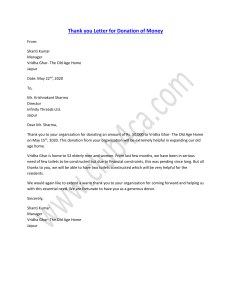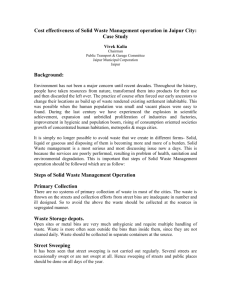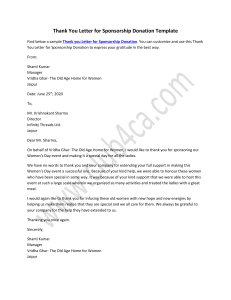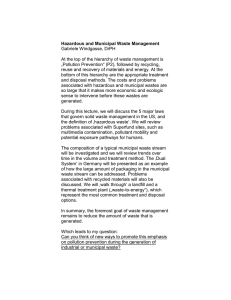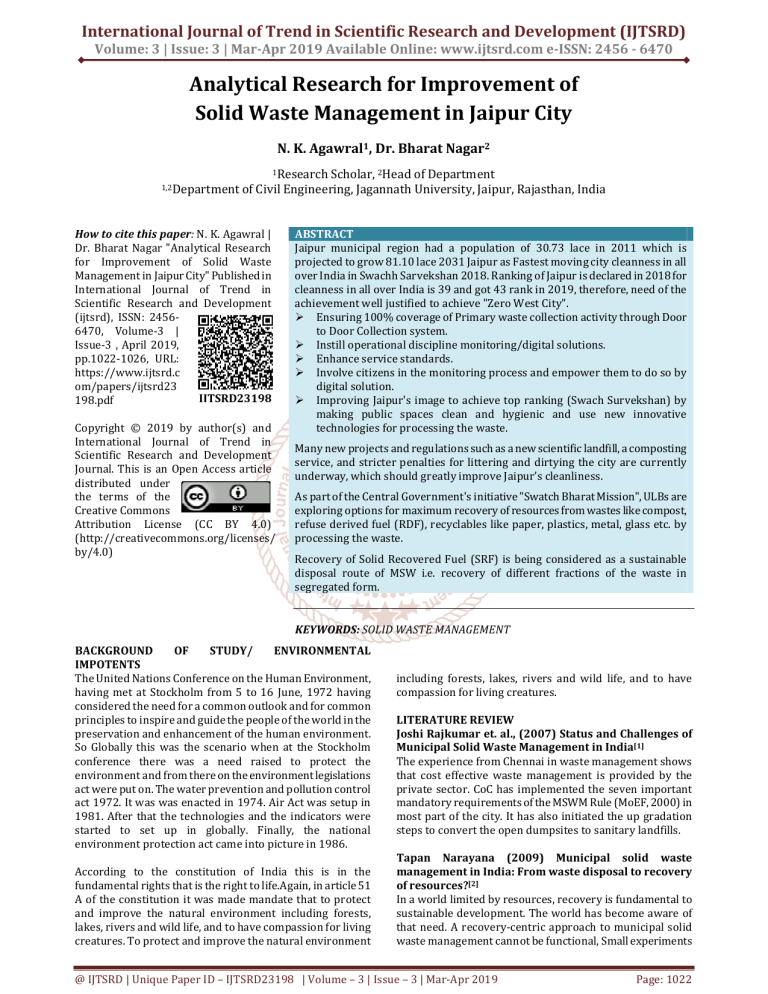
International Journal of Trend in Scientific Research and Development (IJTSRD) Volume: 3 | Issue: 3 | Mar-Apr 2019 Available Online: www.ijtsrd.com e-ISSN: 2456 - 6470 Analytical Research for Improvement of Solid Waste Management in Jaipur City N. K. Agawral1, Dr. Bharat Nagar2 1Research Scholar, 2Head of Department 1,2Department of Civil Engineering, Jagannath University, Jaipur, Rajasthan, India How to cite this paper: N. K. Agawral | Dr. Bharat Nagar "Analytical Research for Improvement of Solid Waste Management in Jaipur City" Published in International Journal of Trend in Scientific Research and Development (ijtsrd), ISSN: 24566470, Volume-3 | Issue-3 , April 2019, pp.1022-1026, URL: https://www.ijtsrd.c om/papers/ijtsrd23 IJTSRD23198 198.pdf Copyright © 2019 by author(s) and International Journal of Trend in Scientific Research and Development Journal. This is an Open Access article distributed under the terms of the Creative Commons Attribution License (CC BY 4.0) (http://creativecommons.org/licenses/ by/4.0) ABSTRACT Jaipur municipal region had a population of 30.73 lace in 2011 which is projected to grow 81.10 lace 2031 Jaipur as Fastest moving city cleanness in all over India in Swachh Sarvekshan 2018. Ranking of Jaipur is declared in 2018 for cleanness in all over India is 39 and got 43 rank in 2019, therefore, need of the achievement well justified to achieve "Zero West City". Ensuring 100% coverage of Primary waste collection activity through Door to Door Collection system. Instill operational discipline monitoring/digital solutions. Enhance service standards. Involve citizens in the monitoring process and empower them to do so by digital solution. Improving Jaipur's image to achieve top ranking (Swach Survekshan) by making public spaces clean and hygienic and use new innovative technologies for processing the waste. Many new projects and regulations such as a new scientific landfill, a composting service, and stricter penalties for littering and dirtying the city are currently underway, which should greatly improve Jaipur’s cleanliness. As part of the Central Government's initiative "Swatch Bharat Mission", ULBs are exploring options for maximum recovery of resources from wastes like compost, refuse derived fuel (RDF), recyclables like paper, plastics, metal, glass etc. by processing the waste. Recovery of Solid Recovered Fuel (SRF) is being considered as a sustainable disposal route of MSW i.e. recovery of different fractions of the waste in segregated form. KEYWORDS: SOLID WASTE MANAGEMENT BACKGROUND OF STUDY/ ENVIRONMENTAL IMPOTENTS The United Nations Conference on the Human Environment, having met at Stockholm from 5 to 16 June, 1972 having considered the need for a common outlook and for common principles to inspire and guide the people of the world in the preservation and enhancement of the human environment. So Globally this was the scenario when at the Stockholm conference there was a need raised to protect the environment and from there on the environment legislations act were put on. The water prevention and pollution control act 1972. It was was enacted in 1974. Air Act was setup in 1981. After that the technologies and the indicators were started to set up in globally. Finally, the national environment protection act came into picture in 1986. According to the constitution of India this is in the fundamental rights that is the right to life.Again, in article 51 A of the constitution it was made mandate that to protect and improve the natural environment including forests, lakes, rivers and wild life, and to have compassion for living creatures. To protect and improve the natural environment including forests, lakes, rivers and wild life, and to have compassion for living creatures. LITERATURE REVIEW Joshi Rajkumar et. al., (2007) Status and Challenges of Municipal Solid Waste Management in India[1] The experience from Chennai in waste management shows that cost effective waste management is provided by the private sector. CoC has implemented the seven important mandatory requirements of the MSWM Rule (MoEF, 2000) in most part of the city. It has also initiated the up gradation steps to convert the open dumpsites to sanitary landfills. Tapan Narayana (2009) Municipal solid waste management in India: From waste disposal to recovery of resources?[2] In a world limited by resources, recovery is fundamental to sustainable development. The world has become aware of that need. A recovery-centric approach to municipal solid waste management cannot be functional, Small experiments @ IJTSRD | Unique Paper ID – IJTSRD23198 | Volume – 3 | Issue – 3 | Mar-Apr 2019 Page: 1022 International Journal of Trend in Scientific Research and Development (IJTSRD) @ www.ijtsrd.com eISSN: 2456-6470 have shown that it is possible to achieve a recovery-centric approach by altering citizen behavior. Based upon the results of this paper, it is very clear that composting after segregation is the best possible option to address solid waste in developed countries. where the Indian government has established composting plants like Villapilsala in the Trivandrum district of Kerala, but the plants have failed due to the lack of streamlined collection of waste by the municipality. The lack of involvement of civil society in the management of municipal solid waste is a major problem. Municipalities should see to it that private participation is made attractive. Hye Jung (2009) The Environmental Effectiveness of Solid Waste Management Case Study Of Oslo, Norwaychoi[3] This research has attempted to examine the effectiveness of Oslo’s solid waste management, in preventing and dealing with environmental problems caused by waste. In order to analyze the environmental effectiveness, I have applied a conceptual framework of environmental effectiveness studies, which examined how international environmental agreements were effective in ameliorating environmental problems, by considering four determinants; regulatory structures, time, economic structures, and science. Biraje, D. D. et. al., (2010) Studies on Status of Solid Waste Management of Kolhapur City[4] At present total solid waste generated in Kolhapur city is 150-160 MT/ day whereas per capita per day generation is 355-370 gms. The municipal solid waste collected door to door by Ghanta Gadi and sent to common storage and treatment site. The contract of collection of solid waste is given to a private agency, RAMKEY Group Pvt. Ltd. The waste collection is carried out by company from 6 am to 2 pm. Two separate bins are provided by company for biodegradable and non-biodegradable waste. Total area covered for collection is 66.82 km. Kolhapur city is divided in 11 sanitary wards and collection is done separately. In the present study it is observed that, different types of vehicles are used for solid waste collection in Kolhapur city. Truck, tipper, dumper, refuse collector are commonly used for collection of waste METHODOLOGY RESEARCH DESIGN A comprehensive study of the status of Municipal Solid Waste Management in Jaipur was done. The study includes the analysis of the every stage of the MSWM i.e. generation, segregation, collection, transportation and disposal of Municipal Solid Waste. Study was done last seven month waste collection. On the basis of these analyses it has been found that there are several methods and procedures through which the status of the current MSWM can be improved. The study will be able to give a lot benefit to all the stakeholders of the Municipal Solid Waste Management like Communities, Nongovernment and other organizations, Informal Sector, Municipal Authority and Other Private Entrepreneurs. The study will let the Municipal Corporation of Jaipur know the current scenario of the practices is going on in door to door waste collection in Jaipur and will give the information of how much they are lagging behind from the standard situation of MSWM. The study area is mainly concerned around the Jaipur city as the study topic is related MSWM in Jaipur. LOCATION The location of study was Jaipur city which is located on 26o 54’ north latitude and 75o 49’ east longitude (Jaipur Development plan, JDA 2010). Its Municipal boundary extends from 26o 46’ to 27o 01’ north latitude and 75o 37’ to 76o 57’ east longitude. The area of Jaipur Municipal Corporation has reached to 288 sq. Km in 2001 with the addition of Bagru, Bassi and Chomu tehsils in the Municipal area (CPCB report, 2007-08). The city was selected on the basis of guidance provided by the host organization. The Municipal area is extends from the Amber in the north to Sanganer in the south and Anand nagar in the west to transport nagar in the east. The fig 4.1 shows the map of Jaipur city. TECHNICAL ASPECTS: SOLID WASTE DISPOSAL IN MUNICIPAL SANITARY LANDFILLS 5.5.1 Disposal of Wastes The city has a total 859-bigha area for municipal land fill sites (CPCB, 2017-18). The three main sites for land filling are Mathuradaspura, Sewapura and Langadiawas areas having an area of 176, 200 and 483 bighas respectively. The waste generated in the city is being depositing at these landfill sites. No scientific method of waste disposal was adopted at Mathuradaspura and Sewapura site. All the waste is disposed at the landfill site by just dumping it. Only one MSW processing plant has been established at Khasra No. 338, village Langadiawas, Tehsil Jamwaramgarh, district Jaipur by M/s Grasim Industries to process municipal solid waste received from Jaipur Municipal Corporation on day-to-day basis. The processing plant designed to handle about 400500 TPD of MSW and generation of 130-140 TPD Refuse Derived Fuel (RDF) in the form of fluff. The basic principal included in the processing of MSW is separation of different categories of waste, having different densities. The composition of waste was expected to contain moisture 25%, inert material 20% and the balance RDF of 30%. Final product, RDF contains mostly cotton fibre, plastic pouches and other light density materials. The RDF produced at Jaipur plant transported to M/s Vikram Cement, Neemuch, M.P. where it is used as a fuel in the kiln to substitute the coal requirement to a maximum extent 10-15% in the kiln (CPCB, 2017-18). Details of the existing dumping sites are given below: 1. Mathuradaspura: This site is located in the east direction of the city. Total area for the site was 176 bighas. This is the oldest site and about 17 Km from the main city. Approximately, 600 to 700 TPD of garbage is being dumped every day at this site. Langadiyawas Plant @ IJTSRD | Unique Paper ID - IJTSRD23198 | Volume – 3 | Issue – 3 | Mar-Apr 2019 Page: 1023 International Journal of Trend in Scientific Research and Development (IJTSRD) @ www.ijtsrd.com eISSN: 2456-6470 2. Langadiya was: This site is located in the east direction of the city, 3 to 4 Km from the Mathuradaspura. The total area of this landfill site is 483-bigha. The JMC has allotted 40-bigha land of it to M/s Grasim Industries Ltd Mumbai to install a plant for processing the municipal solid waste to produce RDF, which is further used as an alternative fuel in the cement industries. From the remaining 443-bigha land 100-bigha is allotted for the sanitary landfill facility (SLF). According to the letter drafted by CPCB to RSPCB dated June 13, 2018, due to poor collection of MSW, RDF plant operated by M/s Grasim Industry is not able to run its full capacity. It was also observed that the waste was being scattered all over the streets and roads leading to unhygienic conditions. The JMC corporation have latest information about the amount of waste disposed to the this site and to processing plant is of dated april 2018 as shown in table 6.5 From the above table it has been clearly seen that in few days there is no amount of waste gone to this site. Approx., 100 to 350 TPD of garbage was being gone every day to this site with the average frequency of trip 15 carried out by the transportation vehicles. Langadiya was Plant 3. Sewapura: This site is located at 20 Km from the main city in North direction on Jaipur-Delhi road. Its total area is 200-bigha. MSW of 21 wards of the Vidyadhar Nagar zone and 16 wards of Civil Line zone and 11 wards of Mansarover zone which comprised of half of the total Civil Line zone dumped to this site. Approximately, 700 to 750 TPD of garbage was being gone every day to this site with the average frequency of trip 29 carried out by the transportation vehicles RESULTS AND DISCUSSION S. No. 1 S. No. 1 Total waste generation in the city 1598 TPD Processing/Management of Wet Waste in Jaipur City Processing/Management of Wet Waste in Jaipur City Wet Waste Total capacity of Total capacity of (40%) In Centralized compost decentralized compost Tons Plant Plant 639 TPD 250 TPD 150 TPD Construction and Demolition Waste Management In Jaipur City Construction And Demolition Waste Management In Jaipur City Status of construction and demolition waste management Currently Nlgam has depolyed hiss vechiles for the management of C & D waste Nagar Nigam has also done tender for C&D waste management Total Processing Capacity 400 TPD Avg C & D waste generation 300 TPD Waste generation, management and dumping in jaipur city S. Avg C & D waste Generation C & D Waste Management / Avg C&D waste Managed (used in Capping No. (In November Month) Facility Location and making of roads at Dumpsites) 1. 200 TPD Mathuradaspura 96 TPD 2. Sewapura 104 TPD Note: Date wise details enclosed in D52 format under Column Mentioned NNJ. S.No. 1 S. No. 1 Table 6.11: Details of Centralized Plant for Dry Waste Processing Details of Centralized Plant for Dry Waste Processing Name of The Waste Processing Plants Total Dry Waste Generated Capacity of The Facility (TPD) (TPD) Langariyawas RDF plant Operated by Ultratech 959 TPD 350 TPD Cement Limited Processing/Management of Dry Waste in Waste in Jaipur City Processing/Management of Dry Waste in Waste in Jaipur City Total waste Dry waste Total capacity of Through generation in the city (60%) Centralized RDF Plant Decentralized Means 1598 TPD 959 TPD 350 TPD 250 TPD Table 6.13: Waste generatedand capacity of the facility Waste generated and capacity of the facility S. Total Wet Waste Name of The Waste Processing Plants No. Generated (TPD) Sewapura Compost Plant Operated by IL & FS 1 639 TPD Environmental Infrastructure & Services Ltd @ IJTSRD | Unique Paper ID - IJTSRD23198 | Volume – 3 | Issue – 3 | Mar-Apr 2019 Total Processing Capacity 600 TPD Capacity of The Facility (TPD) 250 TPD Page: 1024 Data Not Available International Journal of Trend in Scientific Research and Development (IJTSRD) @ www.ijtsrd.com eISSN: 2456-6470 appropriate techniques for MSW treatment. Segregation of waste needs to be enhanced to improve efficiencies at the processing levels. Construction and demolition wastes should be segregated (collected separately) and recycled. Supply of compost produced through composting of MSW to be mandated with the sale of agricultural inputs. Informal sector system of collection and recycling of various materials needs to be strengthened by giving them legal recognition and enhancing their access to institutional finance and relevant technologies. There is a need to review the municipal laws and policies to enable registration of societies of recyclers to operate within the framework of law. Municipal Corporation need to play an important role in proper implementation of the “Recycled Plastics Manufacture and Usage Rules”. Municipal Corporation will be required to create a general public awareness for reducing, reusing and recycling of the wastes. Average Solid Waste Transported in MT/Day for year 2017 Average Solid Waste Transported in MT/Day for year 2018CONCLUSION The following silent observations were carried out from the current research work: As per observation about 1500 to 1800 tonnes per day of municipal waste is generated in the city including of C&D waste, out of which 900 T per day are being processed by way of wet & dry processing, centralized and decentralized system and remaining 600-800 MT are directly being deposited in open dump. According to observation the waste generated varies month to month due to lack of supervision as waste collected company is transported the waste with malba and mitti and also industrial waste (which is violation of RFP condition). The usage of plastics is despoiling the landscape, blocking drainage systems, and affecting health of animals. There is a need to ensure proper collection, segregation, processing and disposal of solid waste. There is a need to develop and implement viable PPP models for setting-up and operating secure landfills, composting plants, waste to energy projects and other RECOMMENDATIONS Ways of Improvemant in Generation and Segregation of Waste (a) For collection mechanism To make the process smooth and hygienic, municipal authority should: Organize awareness programmes. Promote reduction and recycling or reuse of segregated waste. Involve communities in waste management and promotion of home composting, bio-gas generation, decentralised processing of waste at community level subject to control of odour and maintenance of hygienic conditions around the facility; Create public awareness through information, education and communication campaign and educate the waste generators on the following; namely:- (i) not to litter; (ii) minimise generation of waste; (iii) reuse the waste to the extent possible; (iv) practice segregation of waste into bio–degradable, non-biodegradable (recyclable and combustible), sanitary waste and domestic hazardous wastes at source; (v) practice home composting, vermicomposting, bio-gas generation or community level composting; (vi) wrap securely used sanitary waste as and when generated in the pouches provided by the brand owners or a suitable wrapping as prescribed by the local body and place the same in the bin meant for non- biodegradable waste; (vii) storage of segregated waste at source in different bins; (viii) handover segregated waste to waste pickers, waste collectors, recyclers or waste collection agencies; and (ix) pay monthly user fee or charges to waste collectors or local bodies or any other person authorised by the local body for sustainability of solid waste management. Garbage must be picked up from every door step in an organized manner. Waste must be collected at pre-informed timings. The arrival of waste collectors should be announced through methods such as ringing a bell. Waste can be kept inside or outside the house. Different bins for different varieties of wastes must be kept so that each category of waste will follow a different path. For the collection of wastes at door to door level, the following implements may be required: @ IJTSRD | Unique Paper ID - IJTSRD23198 | Volume – 3 | Issue – 3 | Mar-Apr 2019 Page: 1025 International Journal of Trend in Scientific Research and Development (IJTSRD) @ www.ijtsrd.com eISSN: 2456-6470 Increased the number of hand driven carts like wheel barrow. Gloves which do not cause excessive sweating. Bell, horn or any other device to announce arrival for collection. (b) Transportation Mechanism This step refers to the transport of large quantities of waste to treatment sites or the final disposal site. The transport of waste is the bottleneck of efficiency in most Indian cities. In Jaipur also the transport capacity is bound by lengthy loading times (manual loading) from storage areas. Additionally, long distances limit vehicle crews to one or two trips per day, which can be inefficient if the transport volume is small. The longer the distance to the landfill site, the more volume should be transported with each load. In case of long haul distances to the landfill site, transfer stations are found to be most efficient. Vehicles should be selected according to capital costs, carrying capacity, life expectancy, loading speed, local spare part availability, speed, fuel consumption, and maintenance costs. Some general considerations for improvement could be followed: The establishment of more intermediate transfer stations is required (The establishment of intermediate transfer stations is determined by the distance between secondary waste collection points and the final treatment and disposal point. If the distance from the city jurisdiction to the final treatment and disposal points exceeds 15 km, transfer stations may be established.) Setup material recovery facilities or secondary storage facilities with sufficient space for sorting of recyclable materials to enable informal or authorised waste pickers and waste collectors to separate recyclables from the waste and provide easy access to waste pickers and recyclers for collection of segregated recyclable waste such as paper, plastic, metal, glass, textile from the source of generation or from material recovery facilities; Bins for storage of bio-degradable wastes shall be painted green, those for storage of recyclable wastes shall be printed white and those for storage of other wastes shall be printed black; (c) Processing of MSW Investigate and analyse all old open dumpsites and existing operational dumpsites for their potential of biomining and bio-remediation and wheresoever feasible, take necessary actions to bio-mine or bio-remediate the sites; In absence of the potential of bio-mining and bioremediation of dumpsite, it shall be scientifically capped as per landfill capping norms to prevent further damage to the environment. Collect waste from vegetable, fruit, flower, meat, poultry and fish market on day to day basis and promote setting up of decentralised compost plant or biomethanation plant at suitable locations in the markets or in the vicinity of markets ensuring hygienic conditions; JMC is expected to set up a plant for composting waste or to adopt waste-to-energy technology as may be appropriate. Currently, private entrepreneurs are advocating several technologies for the processing and treatment of organic MSW. Some of the technologies have been used in India in the past, such as microbial composting and vermin-composting, whereas some are based on applications used in foreign countries that have yet to be tried in India or that have failed in India. The issue of suitability to local conditions, including local technical knowledge, operation capacity and cost of maintenance. JMC should also consider seeking expert opinion from outside the municipality. (d) Digital Solutions by ICT Intervention Installation of GPRS or RFID systems is required, GIS provides real-time data on vehicles, collection of waste, bin pickup, and transportation of waste to treatment or disposal facilities. These systems are now being suitably adopted by cities to improve service efficiency of MSWM. These system will help in monitor the actual movement and realtime position of the vehicle; Monitor the movement of collection vehicles; Improve the service delivery mechanism and achieve better information management; Ensure citizens’ participation in governance mechanism for overall improvements in collection efficiency; Reduce unwanted trips, detours, or stoppages, thereby enhancing the productivity or utilisation of the fleet; Generate management information system (MIS) report daily to take informed decision; and publish the “Bin Pickup Status” on their website to inform citizens and encourage them to monitor bin pickup status in their localities. (e) Disposal of Waste The Plant of waste to energy having capacity of 700 TPD should start as soon as possible as NNJ has processing capacity of 600 tons more than 700 ton is being dumped at dumpsites of sewapura and Mathuradaspura. Landfill site should be developed for disposal of inerts materials generated through the processing units at sewapura compost plant and langariyawas RDF plant. Make adequate provision of funds for capital investments as well as operation and maintenance of solid waste management services in the annual budget ensuring that funds for discretionary functions of the local body have been allocated only after meeting the requirement of necessary funds for solid waste management and other obligatory functions of the local body as per these rules; (e) Hazardous Waste, e-Waste and Bio-Medical Waste Establish waste deposition centres for domestic hazardous waste and give direction for waste generators to deposit domestic hazardous wastes at this centre for its safe disposal. Such facility shall be established in a city or town in a manner that one centre is set up for the area of twenty square kilometers or part thereof and notify the timings of receiving domestic hazardous waste at such centres; Ensure safe storage and transportation of the domestic hazardous waste to the hazardous waste disposal facility or as may be directed by the State Pollution Control Board or the Pollution Control Committee; @ IJTSRD | Unique Paper ID - IJTSRD23198 | Volume – 3 | Issue – 3 | Mar-Apr 2019 Page: 1026


